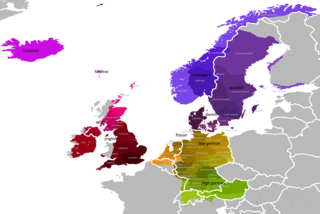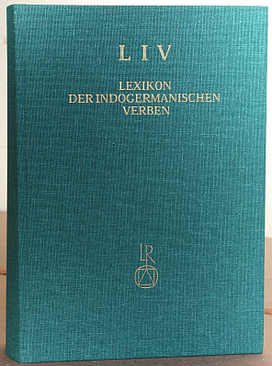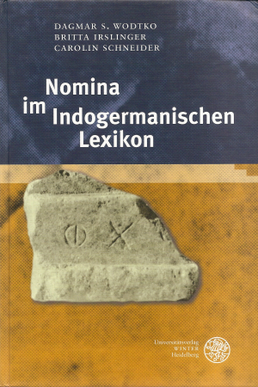Related Research Articles

The Germanic languages are a branch of the Indo-European language family spoken natively by a population of about 515 million people mainly in Europe, North America, Oceania and Southern Africa. The most widely spoken Germanic language, English, is also the world's most widely spoken language with an estimated 2 billion speakers. All Germanic languages are derived from Proto-Germanic, spoken in Iron Age Scandinavia.

The Indo-European languages are a language family native to the overwhelming majority of Europe, the Iranian plateau, and the northern Indian subcontinent. Some European languages of this family—English, French, Portuguese, Russian, Dutch, and Spanish—have expanded through colonialism in the modern period and are now spoken across several continents. The Indo-European family is divided into several branches or sub-families, of which there are eight groups with languages still alive today: Albanian, Armenian, Balto-Slavic, Celtic, Germanic, Hellenic, Indo-Iranian, and Italic/Romance; and another nine subdivisions that are now extinct.
In linguistics, the Indo-European ablaut is a system of apophony in the Proto-Indo-European language (PIE).
The laryngeal theory is a theory in the historical linguistics of the Indo-European languages positing that:

Proto-Indo-European (PIE) is the reconstructed common ancestor of the Indo-European language family. No direct record of Proto-Indo-European exists; its proposed features have been derived by linguistic reconstruction from documented Indo-European languages.

The Balto-Slavic languages form a branch of the Indo-European family of languages, traditionally comprising the Baltic and Slavic languages. Baltic and Slavic languages share several linguistic traits not found in any other Indo-European branch, which points to a period of common development and origin.
Vṛddhi is a technical term in morphophonology given to the strongest grade in the vowel gradation system of Sanskrit. The term is derived from Sanskrit वृद्धि vṛddhi, IPA:[ˈʋr̩d̪ːʱi], lit. 'growth', from Proto-Indo-European *werdʰ- 'to grow'.

Indo-Uralic is a controversial language family consisting of Indo-European and Uralic.
In historical linguistics, vowel breaking, vowel fracture, or diphthongization is the sound change of a monophthong into a diphthong or triphthong.

Karl Brugmann was a German linguist. He is noted for his work in Indo-European linguistics.

Robert Stephen Paul Beekes was a Dutch linguist who was emeritus professor of Comparative Indo-European Linguistics at Leiden University and an author of many monographs on the Proto-Indo-European language.

The Lexikon der indogermanischen Verben is an etymological dictionary of the Proto-Indo-European (PIE) verb. The first edition appeared in 1998, edited by Helmut Rix. A second edition followed in 2001. The book may be seen as an update to the verb entries of the Indogermanisches etymologisches Wörterbuch (IEW) by Julius Pokorny. It was the first dictionary fully utilizing the modern three-laryngeal theory with reconstructions of Indo-European verbal roots.
In Indo-European studies, the term s-mobile designates the phenomenon where a PIE root appears to begin with an *s- which is sometimes but not always present. It is therefore represented in the reflex of the root in some attested derivatives but not others. The fact that there is no consistency about which language groups retain the s-mobile in individual cases is good evidence that it is an original Indo-European phenomenon, and not an element added or lost in the later history of any specific language.
Brugmann's law, named for Karl Brugmann, is a sound law stating that in the Indo-Iranian languages, the earlier Proto-Indo-European *o normally became *a in Proto-Indo-Iranian but *ā in open syllables if it was followed by one consonant and another vowel. For example, the Proto-Indo-European noun for 'wood' was *dόru, which in Vedic became dāru. Everywhere else, the outcome was *a, the same as the reflexes of PIE *e and *a.
Proto-Indo-European nominals include nouns, adjectives, and pronouns. Their grammatical forms and meanings have been reconstructed by modern linguists, based on similarities found across all Indo-European languages. This article discusses nouns and adjectives; Proto-Indo-European pronouns are treated elsewhere.
The roots of the reconstructed Proto-Indo-European language (PIE) are basic parts of words that carry a lexical meaning, so-called morphemes. PIE roots usually have verbal meaning like "to eat" or "to run". Roots never occurred alone in the language. Complete inflected verbs, nouns, and adjectives were formed by adding further morphemes to a root and potentially changing the root's vowel in a process called ablaut.
Kluge's law is a controversial Proto-Germanic sound law formulated by Friedrich Kluge. It purports to explain the origin of the Proto-Germanic long consonants *kk, *tt, and *pp as originating in the assimilation of *n to a preceding voiced plosive consonant, under the condition that the *n was part of a suffix which was stressed in the ancestral Proto-Indo-European (PIE). The name "Kluge's law" was coined by Kauffmann (1887) and revived by Frederik Kortlandt (1991). As of 2006, this law has not been generally accepted by historical linguists.
Jens Elmegård Rasmussen was associate professor of Indo-European Studies and head of the Roots of Europe research center at the University of Copenhagen from its initiation in 2008 until his death. He was an expert on Proto-Indo-European and Indo-European languages in general, especially morphophonemics, but he also published articles on the history of Eskimo–Aleut languages and linguistic diachrony. He supported the Indo-Uralic and Eurasiatic hypotheses.

Nomina im Indogermanischen Lexikon is an etymological dictionary of the Proto-Indo-European (PIE) nominals, that is, nouns and adjectives. It appeared in 2008, edited by German linguists Dagmar S. Wodtko, Britta Irslinger, and Carolin Schneider. Like other modern PIE dictionaries, NIL utilizes the modern three-laryngeal theory for its reconstructions.

In Indo-European studies, the salmon problem or salmon argument is an outdated argument in favour of placing the Indo-European urheimat in the Baltic region, as opposed to the Eurasian Steppe, based on the cognate etymology of the respective words for salmon in Germanic and Balto-Slavic languages. The word's wide distribution likely means it existed in its current form in a Proto-Indo-European language.